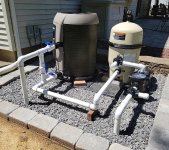Morning gang. Few questions I have since pool opening season is coming close:
1. Plumbed my 1st AGP last year and wanted a way to blow out the lines in the winter so I added a few 3 way Jandy's with one port stubbed and temporarily capped. This port when closed does leak a tiny bit. Some have mentioned these valves were not meant for this but it worked well. I cover all equipment in the winter and my pump is hardwired so it would be a pain to disconnect and take in each year. This year with some member recommendations, I am going to add a union with glued caps at this port. My question is would it be better to leave the valve position where all 3 ports are open or continue to have the port with the stub closed? The reason for this question is last year whenever I removed the temporary cap, some water that was built up that came out had algae (I am assuming). I think because that port is closed and capped the water doesn't get filtered and is stagnant.
2. I am planning on adding 2 more 3 way valves at my heater's in/out ports for the same reason for winterizing. (Replace the ball valves in pic) In addition when my heater is not being used, I can use the bypass and open the ports and blow water out of the heater to prevent water from staying in the heater for extended periods. Also last winter I unscrewed the unions at the heater and moved the heater several inches to allow me to blow out water from the heater. It also allowed me to blow out the return line. With 3-way valves this would be prevented. Good/bad idea?
Thanks in advance!
1. Plumbed my 1st AGP last year and wanted a way to blow out the lines in the winter so I added a few 3 way Jandy's with one port stubbed and temporarily capped. This port when closed does leak a tiny bit. Some have mentioned these valves were not meant for this but it worked well. I cover all equipment in the winter and my pump is hardwired so it would be a pain to disconnect and take in each year. This year with some member recommendations, I am going to add a union with glued caps at this port. My question is would it be better to leave the valve position where all 3 ports are open or continue to have the port with the stub closed? The reason for this question is last year whenever I removed the temporary cap, some water that was built up that came out had algae (I am assuming). I think because that port is closed and capped the water doesn't get filtered and is stagnant.
2. I am planning on adding 2 more 3 way valves at my heater's in/out ports for the same reason for winterizing. (Replace the ball valves in pic) In addition when my heater is not being used, I can use the bypass and open the ports and blow water out of the heater to prevent water from staying in the heater for extended periods. Also last winter I unscrewed the unions at the heater and moved the heater several inches to allow me to blow out water from the heater. It also allowed me to blow out the return line. With 3-way valves this would be prevented. Good/bad idea?
Thanks in advance!


